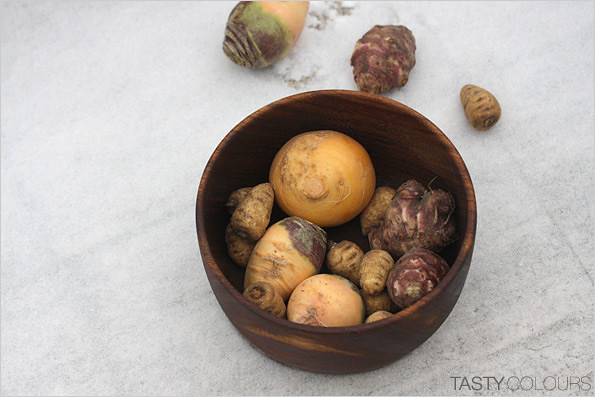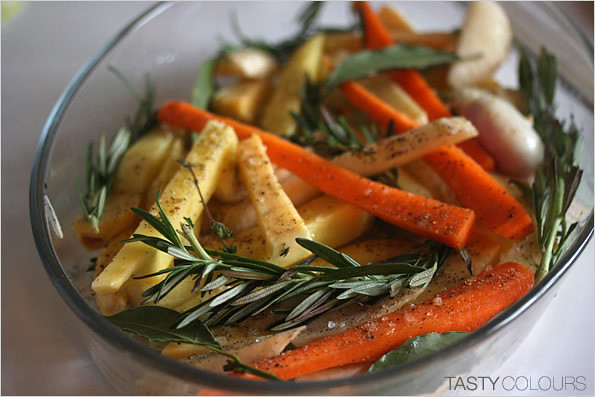Sometime I find a recipe which I would like to cook right away, but for some reasons it must “wait”, like a good wine. More than one year ago, when I was in Paris, my husband was awaiting surgery. We were sitting one Sunday morning in the kitchen and we were listening to the program about cooking “On va deguster” which is broadcasted every Sunday on France Inter, a French public radio station. Chefs, pastry chefs, famous bloggers and food producers are invited to the program. On va deguster reminds me that when I was a small girl, I was often sick. When I was sick, I used to stay home alone. I was reading books, but the radio had to be turned on all the time. You might not know about that, but in the middle of the eighties, in Poland, we had only two TV channels and there were no programs for kids during the day. There was no video recorder in my family. The radio was the only option to be entertained.
Coming back to this program which we listened to one year ago: it was about pork meat. The special guest of the program was, inter alia, Eric Ospital, a renowned producer of pork and hams from the south of France - close to the Pyrenees (he produces, inter alia, Jambon Ibaiona, Jambon Pays Basque). Today’s recipe is his recipe for a slowly braised pork belly. Why I decided to cook this? Because the idea of this pork belly is to have two textures – “fondant et croquant” – soft, nearly melting meat – “fondant” and covered by crispy external crust ("croquant"). He advises to braise the pork belly for 12 hours. In my case 8 hours were sufficient (I used a relatively small piece of pork belly). The finishing in butter gives the crispy texture outside.
I served it with baked, winter, ancient vegetables: “racine de cerfeuil” (tuberous-rooted chervil, bulbous chervil), yellow – violet rutabaga (swede), yellow turnips, Jerusalem artichokes, potatoes and carrots – baked with fresh bay leaves and fresh rosemary.
Do you know “racine de cerfeuil”? In latin it is called Chaerophyllum bulbosum, in English “tuberous-rooted chervil”, “bulbous chervil”. It is root vegetable which was popular in the past (allegedly a specie from the carrot family), a native of Europe and Western Asia. The tuberous-rooted chervil was a popular vegetable in the 19th century.
This mysterious rooted chervil was also known in Poland and was called “świerząbek”. And you will not believe, but it is mentioned as “popie jajka” (“priest testicles”) in the first Polish cookbook – the famous Compendium Ferculorum, written and published in the 17th century (described in details in my January post.
The vegetable can be eaten raw (thinly sliced, sprinkled with olive oil, lemon juice, salt and pepper), it may be boiled, baked or fried. It is starchy, like topinambur and potatoes (especially once baked in the oven), but sweet like parsley root or parsnip. It grows in Poland in fields, as topinambour (Jerusalem artichoke), but I do not believe that it is available in any store in Poland. Now forgotten in Britain and in the United States, allegedly root chervil is still used in French cuisine, in soups or stews. One more thing: after two weeks in Paris, I have an impression that topinambour is as common as potatoes. I have checked: one can buy topinambour in every food market in Paris, in food stores like Monoprix, in stores with bio food (Bio c’bon), Naturalia,and even in food discount stores. The price is between 3 and 4 euro a kilo.
I found the rooted chervil two weeks ago, on the food market boulevard Raspail – the one, where I used to do my shopping every Tuesday and every Friday when we lived rue de Bérite. Almost everything looks the same. The same “poissonniers” sell fresh seafood, the same man in glasses pushing you to buy vegetables and the same guy selling farmers’ cheeses. One thing was new – Americans selling specialties including burgers straight from “a food truck”. They called themselves “Cantina California”. It seems that "street food" is trendy in Paris, which is not so obvious, because: a) a typical French person hates to eat with hands – and the burgers the American guys sell are huge and juicy and you HAVE to eat them with your hands b) a typical French person does not eat outside, standing up – he or she MUST sit down; c) a typical French person does not like to eat in a hurry. The first “food truck” in Paris was “Le camion qui Fume” which appeared in some Parisian streets in November 2011 and it was a huge success. The “Cantina California”, the competitor, which has only been in business for a few months is also successful. Both published their burgers cookbooks which are available in Fnac stores.
Slowly Braised Pork Belly (by Eric Ospital)
Ingredients:
(serves 2)
500-600 g raw, nice pork belly (as it does not contain too much meat, you should count around 300 grams per person (which includes abound 120 grams of meat)
2 grains all spice
Few brines fresh thyme
2 bay leaves (most possibly, fresh ones)
2 small carrots, peeled and washed, cut into slices
2 medium onions, cut into halves
1 liter chicken stock
1 medium leek (white part), washed and cut into slices
50 g butter
Black pepper grains
Chives, finely chopped, for garnishing
Salt
Pepper
1.Brown onions on a dry frying pan or over the fire. Place pork belly in a saucepan. Add carrots, onions, thyme, laurel leaves, all spice, pepper grains and cover with the stock (if you do not have enough, add some white wine or water). Bring to a boil and then reduce the heat to a minimum and cook under the cover for 12 hours. You should check the cooking time because my pork belly was “fondant” after 8 hours.
2. Cool down and refrigerate overnight.
3. On the next day: cut the pork belly into thick slices. Heat the pan, reduce the heat to a minimum, add butter and melt it. Place pieces of belly in the pan, it should caramelize on all sides between 20-30 minutes, until it is brown and crispy. Sprinkle with chives or parsley, serve with vegetables (the recipe below) and also with a green salad (for digestion) as advised by Eric Ospital.
Roasted Ancient Root Vegetables
Serves 2-3
Ingredients:
2 medium Jerusalem artichoke (topinambour) - around 100 g
150 g racine de cerfeuil (tuberous-rooted chervil) around 6 pieces
1 medium rutabaga (around 100 g)
1 medium yellow turnip (“boule d’or)
1 medium potato
1 carrot
Fresh rosemary
Fresh thyme
Olive oil
3-4 bay leaves
Salt
Pepper
Peel and wash vegetables. Dry them out. Cut into strips (French fries type). Pour olive oil and mix. Salt generously, pepper. Place in a pan, add rosemary, thyme and bay leaves. Bake in the oven preheat to 180 degrees for around 30 minutes, occasionally mixing. Serve with braised pork belly.
Smacznego !
Smacznego !











